
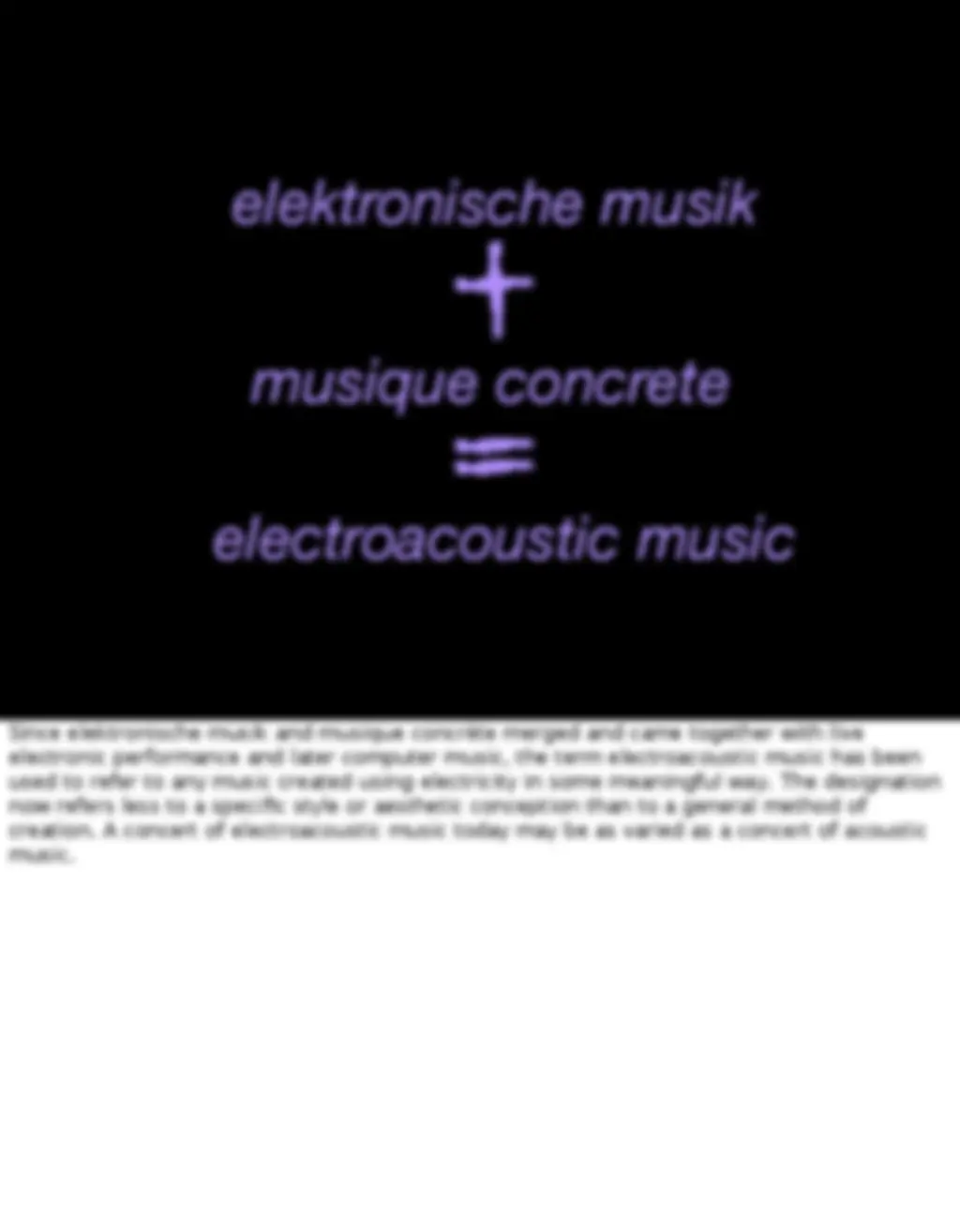
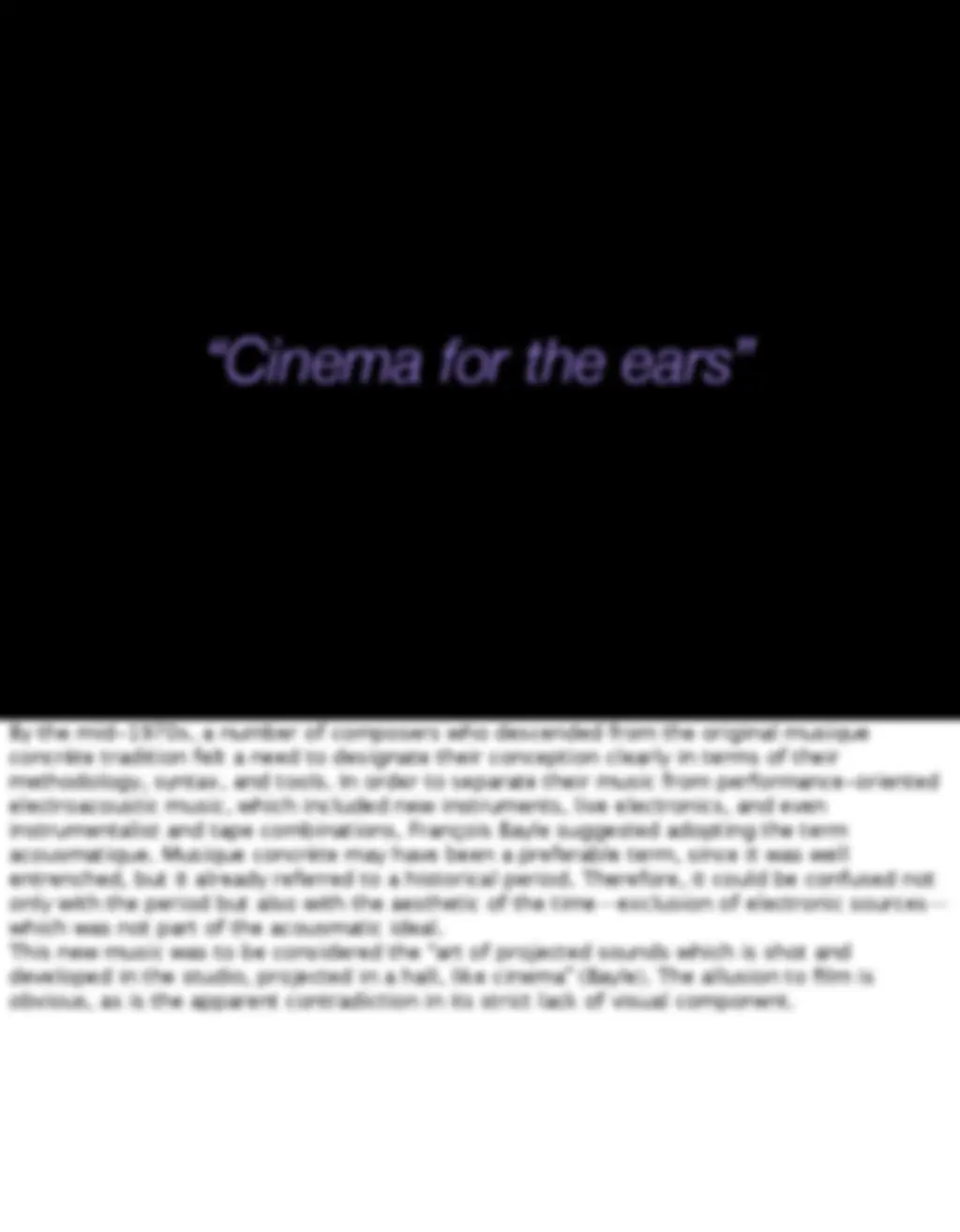
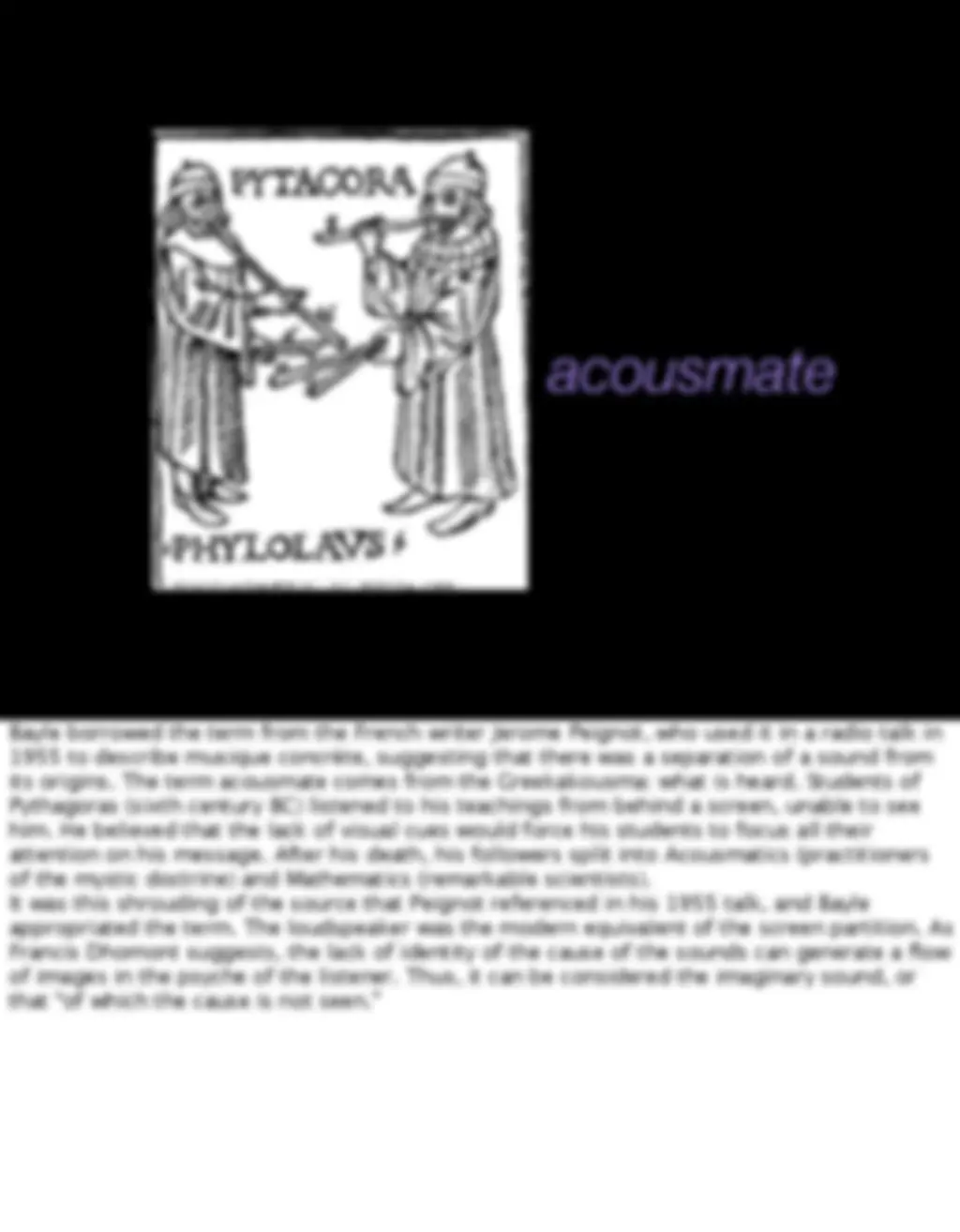
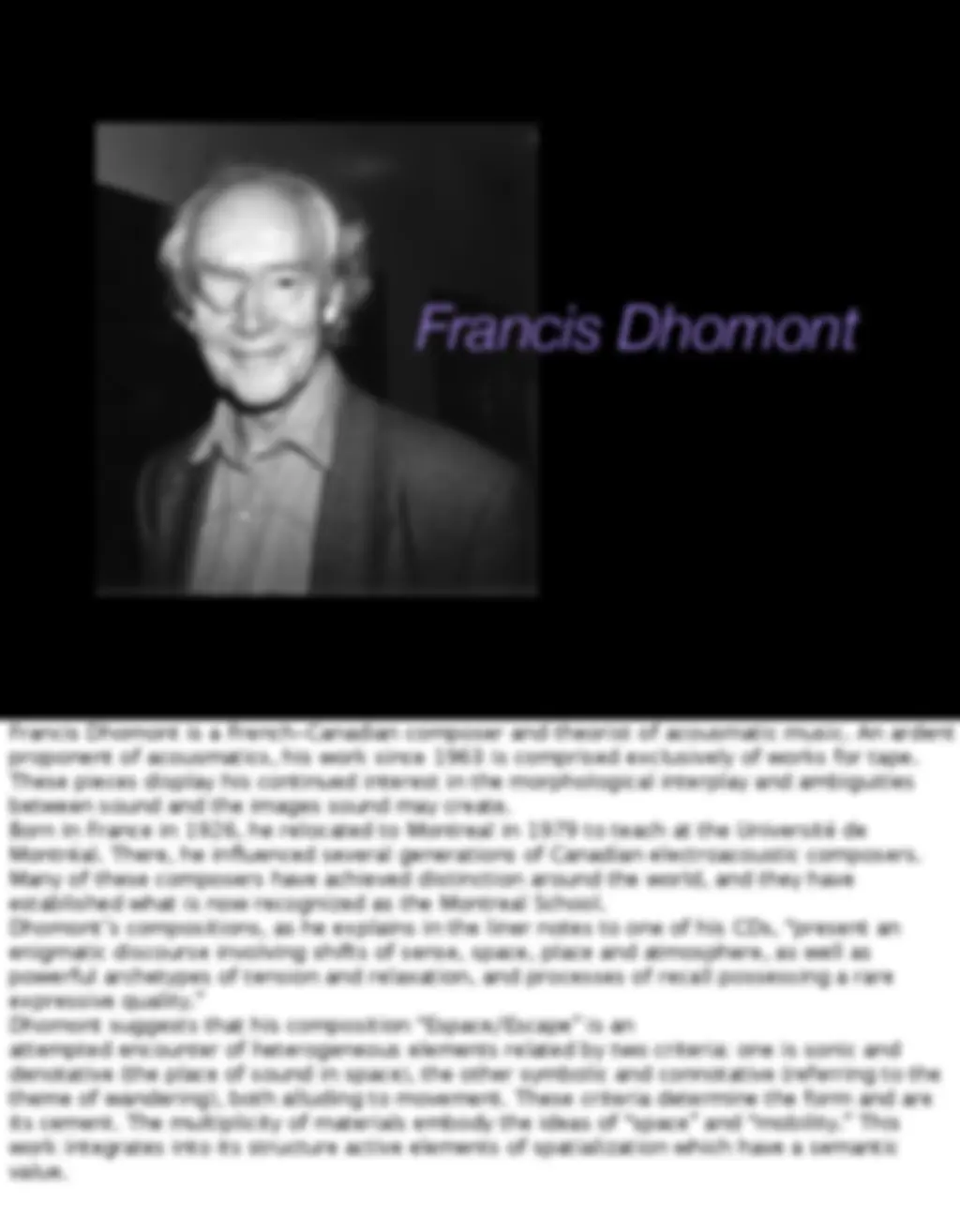
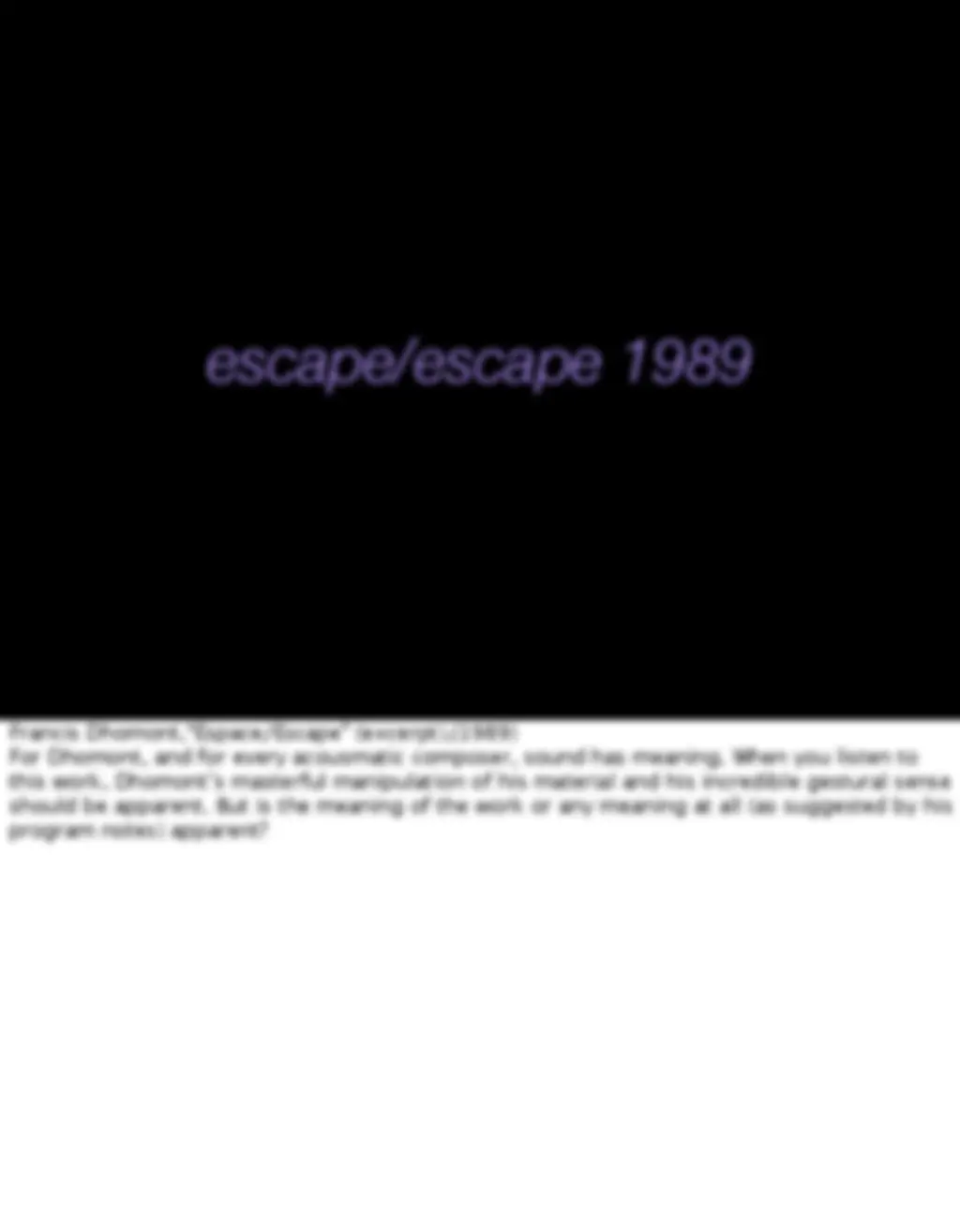
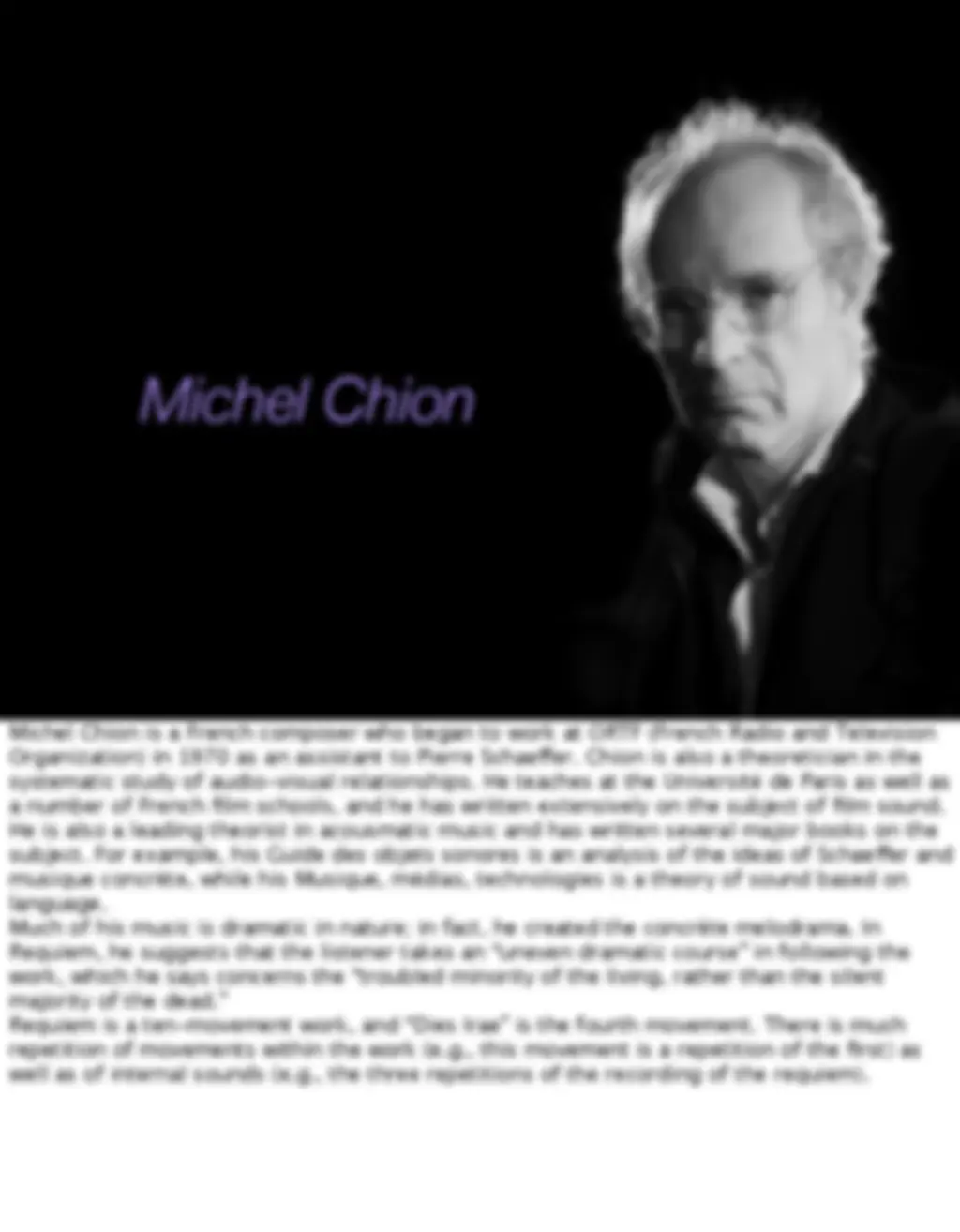
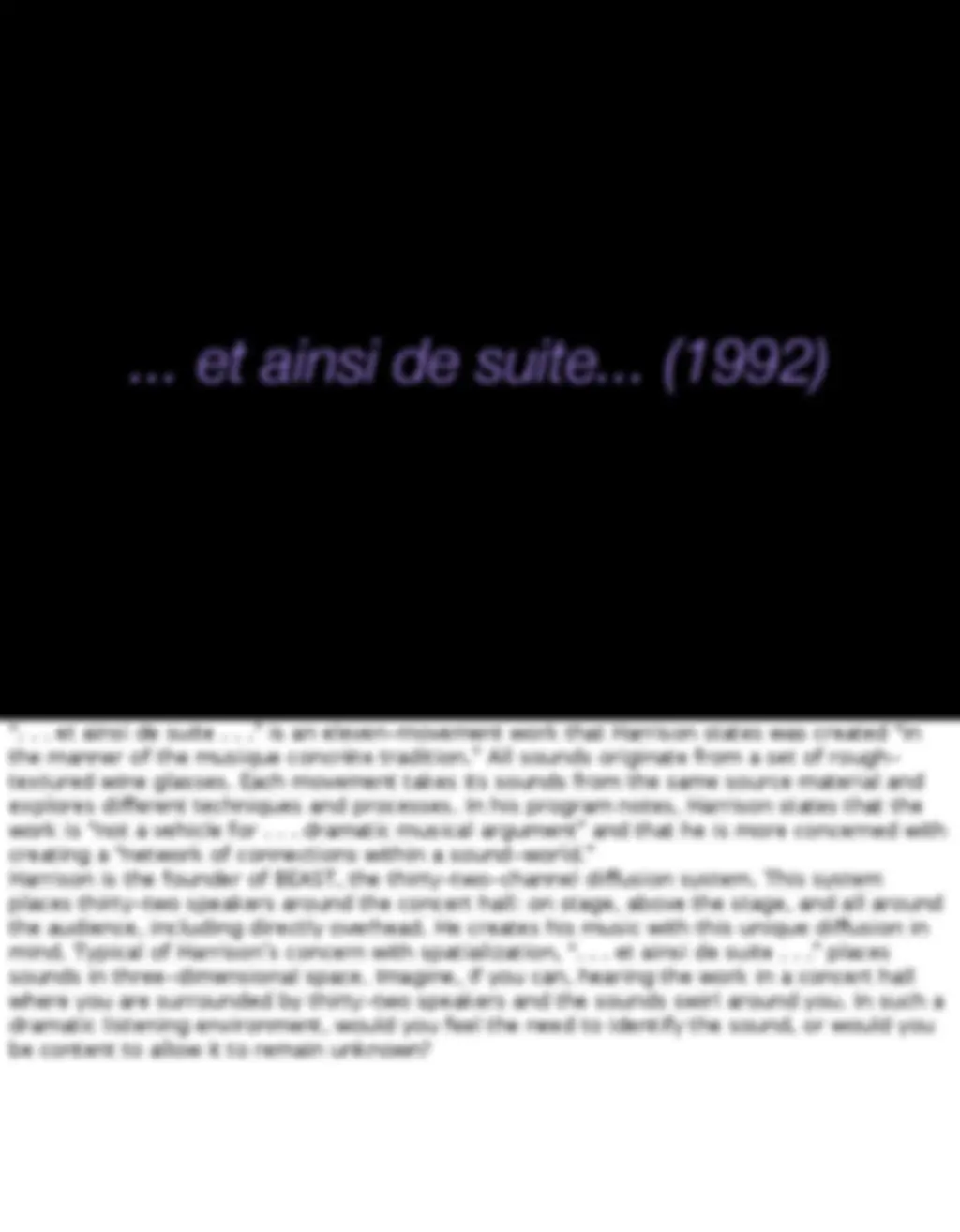
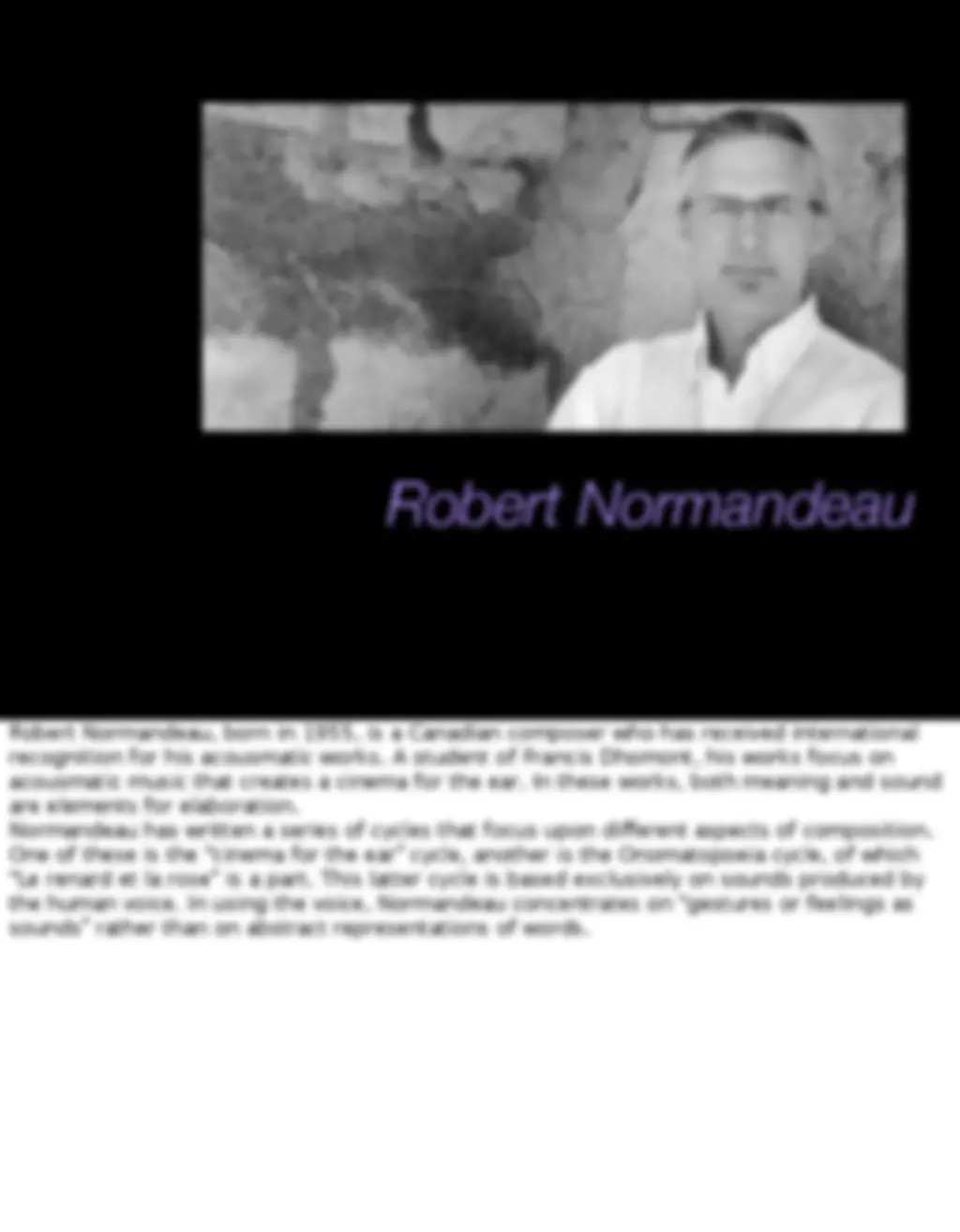
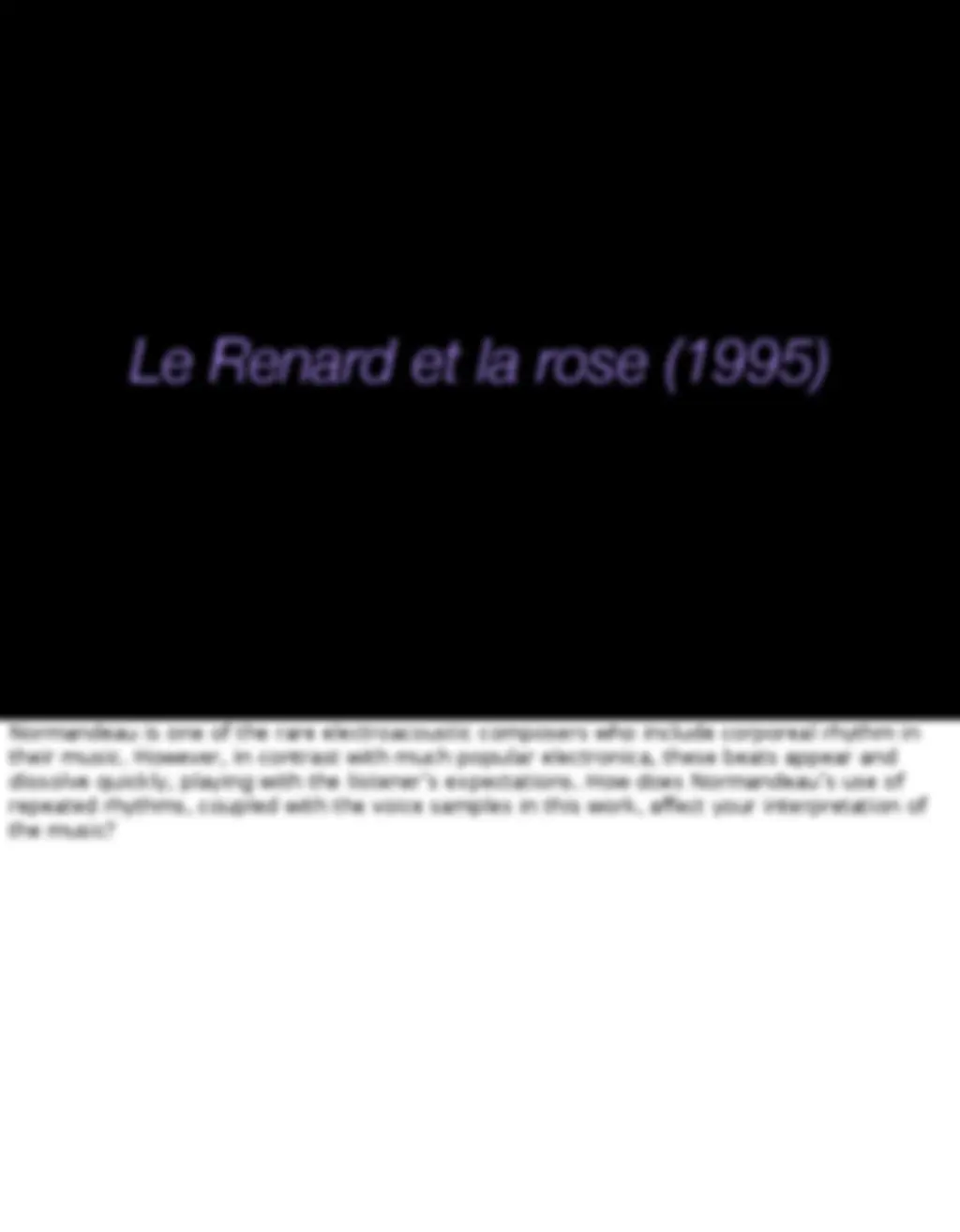
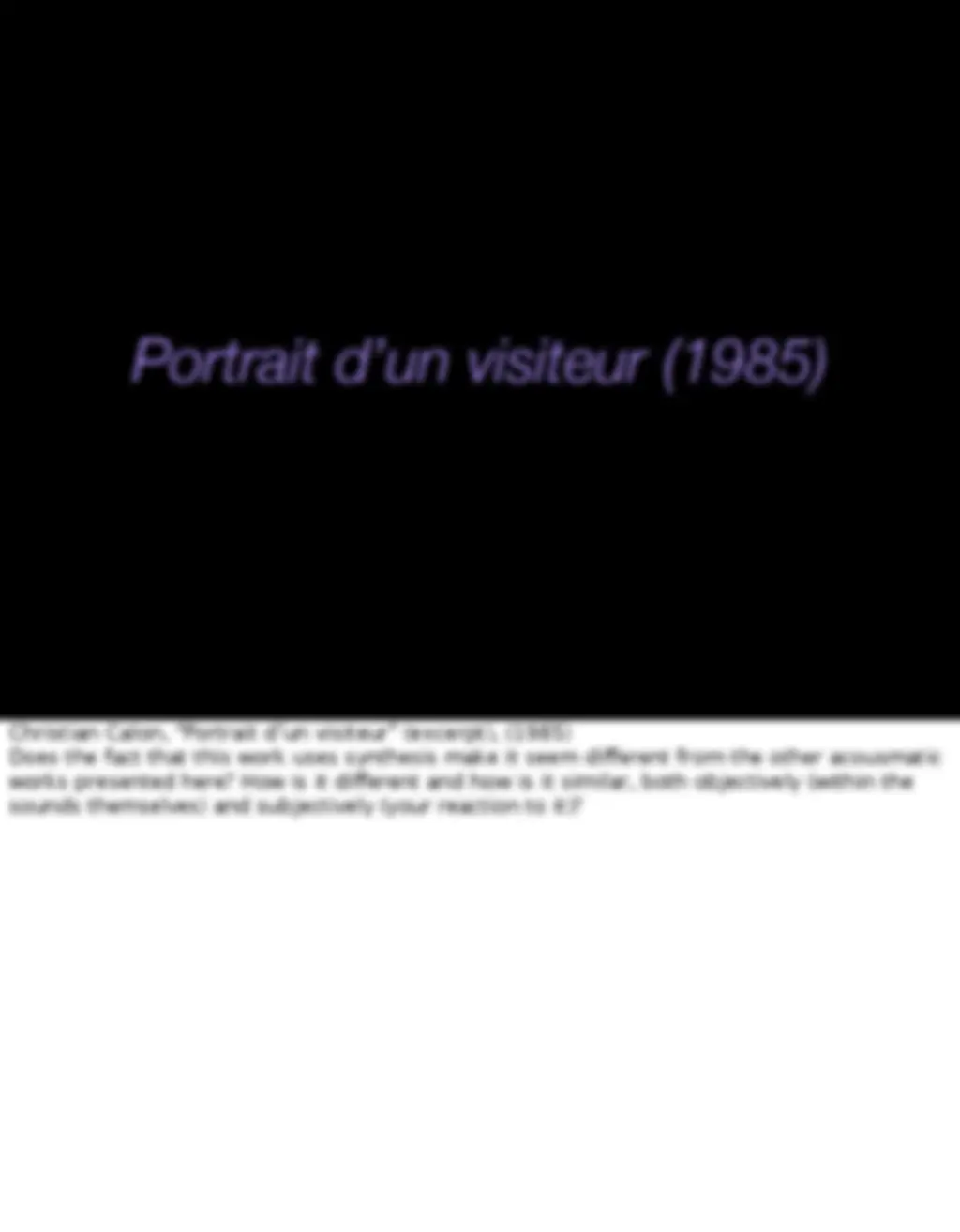
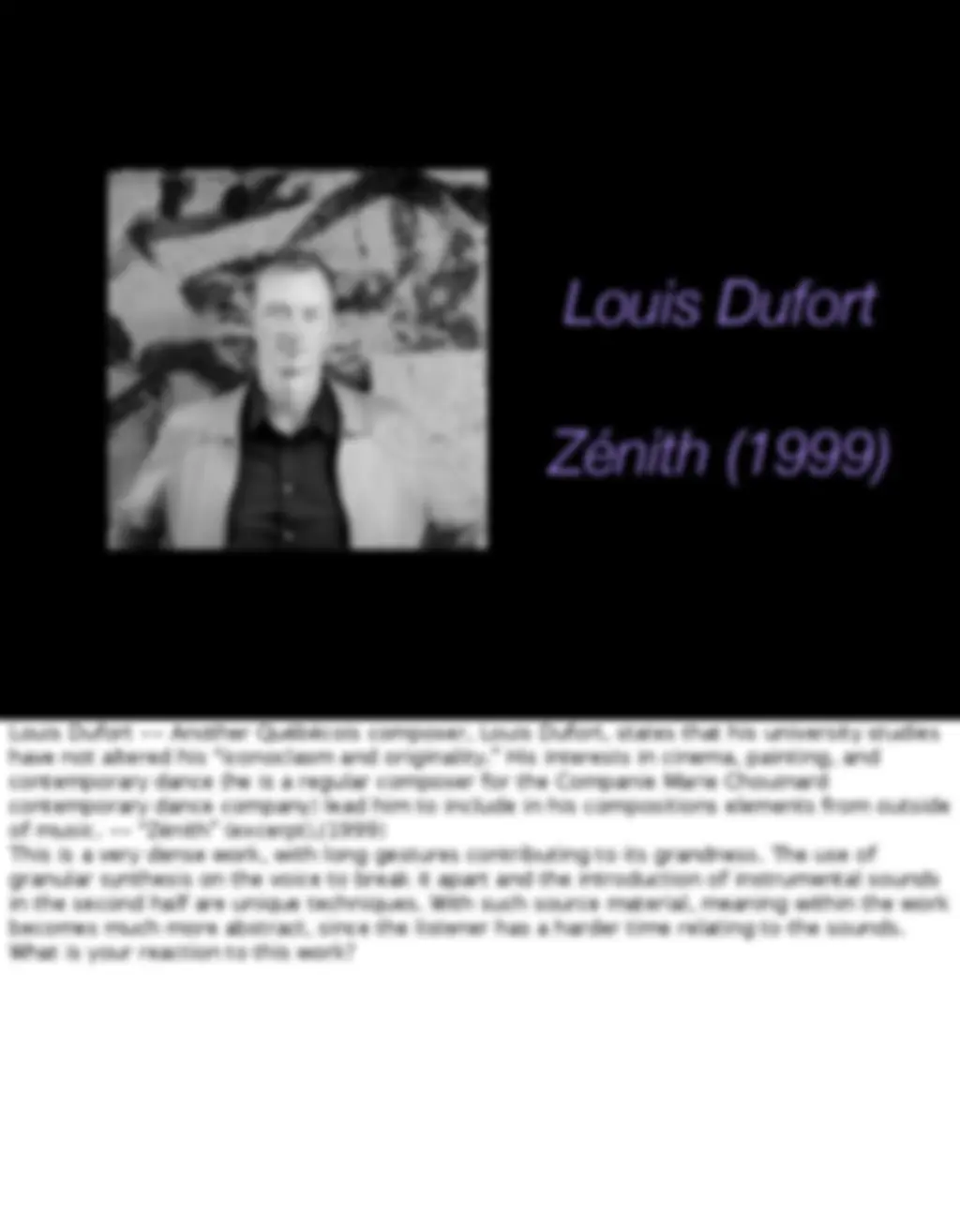
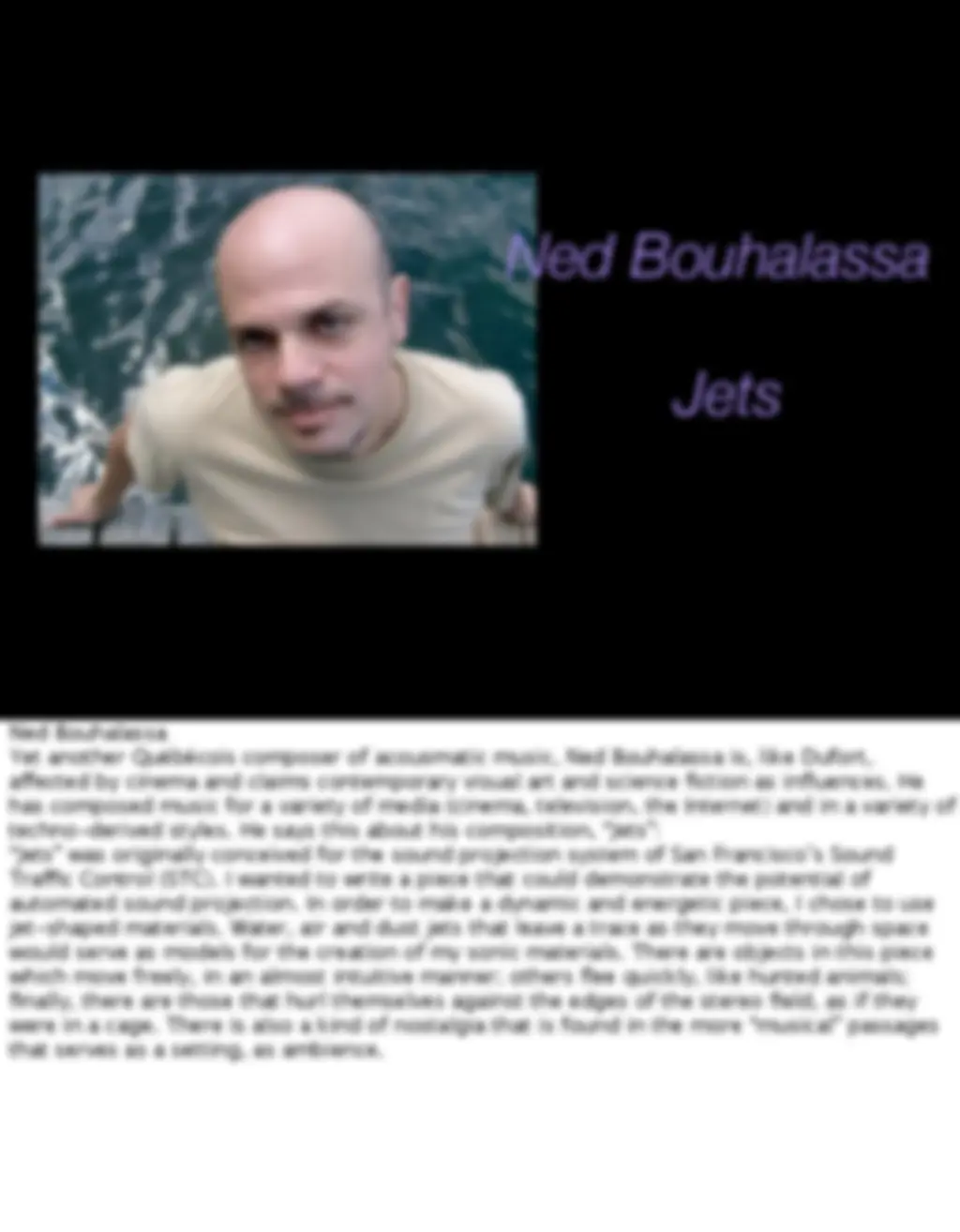
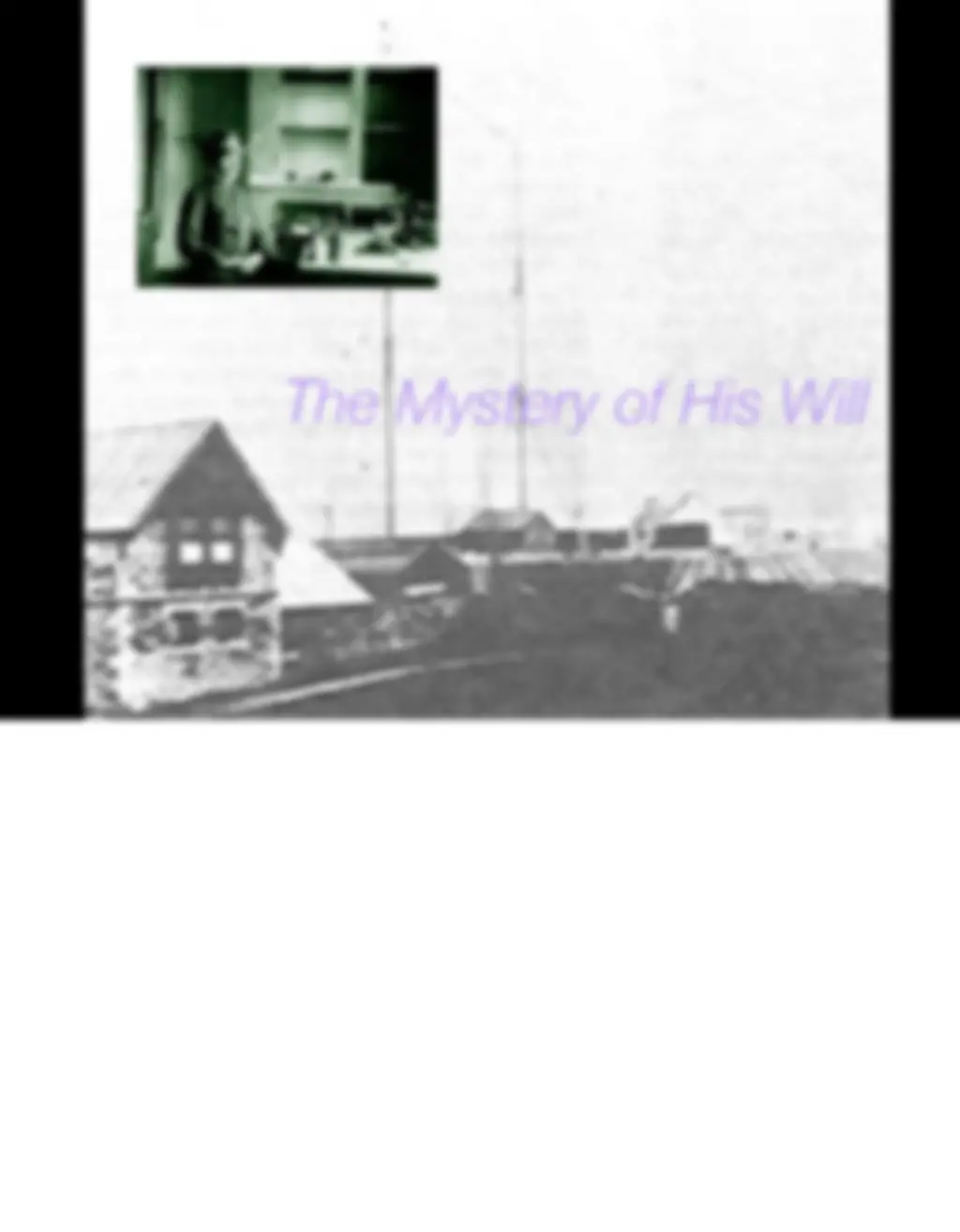
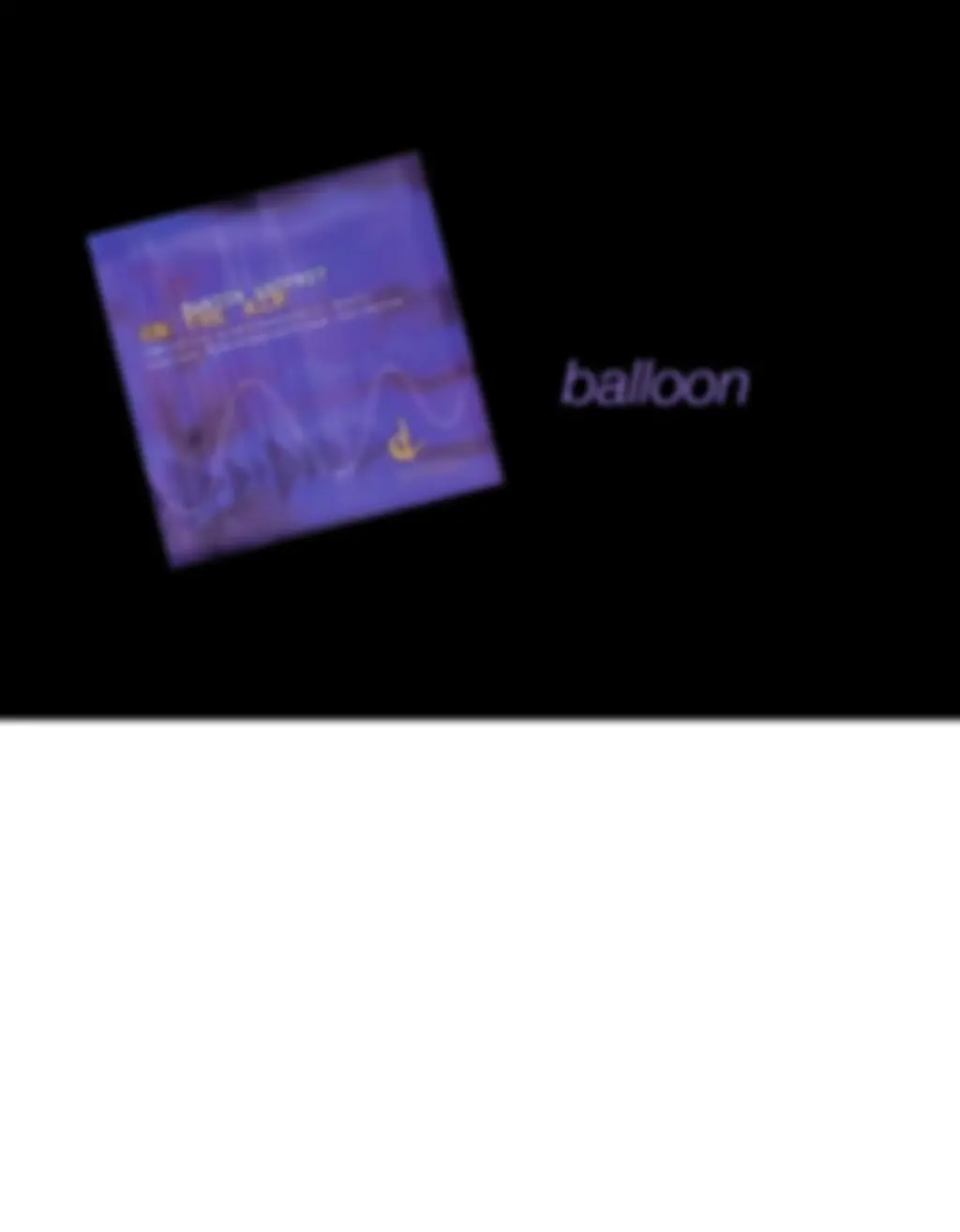


Study with the several resources on Docsity

Earn points by helping other students or get them with a premium plan


Prepare for your exams
Study with the several resources on Docsity

Earn points to download
Earn points by helping other students or get them with a premium plan
Community
Ask the community for help and clear up your study doubts
Discover the best universities in your country according to Docsity users
Free resources
Download our free guides on studying techniques, anxiety management strategies, and thesis advice from Docsity tutors
The history and evolution of acousmatic music, a modern form of musique concrète. It discusses how composers like Schaeffer and Bayle began using sound as the foundation for musical structures, leading to the merger of electroacoustic music. The document also introduces key figures in the field, such as Michel Chion and Francis Dhomont, and their contributions to the genre.
Typology: Exams
1 / 22

This page cannot be seen from the preview
Don't miss anything!















Acousmatic music is the modern evolution of musique concrète. When Schaeffer began composing with sound in the 1940s, it slowly became apparent that the traditional models of acoustic composition did not apply well. Apart from the fact that composers were no longer dealing with collections of notes (either scales or chords), the entire conception of musique concrète was different. Schaeffer began with the sound (the concrete), and after applying various studio techniques (editing, filtering, reversal, etc.), he began to apply musical techniques to their combinations (repetition, transposition, reordering, etc.) to create musical structures (the abstract). This is exactly the opposite of the acoustic tradition, in which a composer begins with the abstract (the notes) and only creates sound when the composition is performed. Listeners could not apply their conditioned responses to the new music, and thus they required a new mode of interpreting the sounds they heard.
By the mid-1970s, a number of composers who descended from the original musique concrète tradition felt a need to designate their conception clearly in terms of their methodology, syntax, and tools. In order to separate their music from performance-oriented electroacoustic music, which included new instruments, live electronics, and even instrumentalist and tape combinations, François Bayle suggested adopting the term acousmatique. Musique concrète may have been a preferable term, since it was well entrenched, but it already referred to a historical period. Therefore, it could be confused not only with the period but also with the aesthetic of the time—exclusion of electronic sources— which was not part of the acousmatic ideal. This new music was to be considered the “art of projected sounds which is shot and developed in the studio, projected in a hall, like cinema” (Bayle). The allusion to film is obvious, as is the apparent contradiction in its strict lack of visual component.
Bayle borrowed the term from the French writer Jerome Peignot, who used it in a radio talk in 1955 to describe musique concrète, suggesting that there was a separation of a sound from its origins. The term acousmate comes from the Greekakousma: what is heard. Students of Pythagoras (sixth century BC) listened to his teachings from behind a screen, unable to see him. He believed that the lack of visual cues would force his students to focus all their attention on his message. After his death, his followers split into Acousmatics (practitioners of the mystic doctrine) and Mathematics (remarkable scientists). It was this shrouding of the source that Peignot referenced in his 1955 talk, and Bayle appropriated the term. The loudspeaker was the modern equivalent of the screen partition. As Francis Dhomont suggests, the lack of identity of the cause of the sounds can generate a flow of images in the psyche of the listener. Thus, it can be considered the imaginary sound, or that “of which the cause is not seen.”
Heard over loudspeakers
Displays an acousmatic intent
Composed on and exists on “fixed” medium
Physical source (if any) of the sound is not present at the time of listening
Source , nature or cause of sound may be unknowable or unknown
Compositional criteria extends beyond what is normally considered musical Heard over loudspeakers. The reproduction of the recorded music over loudspeakers is not a by- product but the intent of the composer. In concert, this reproduction may occur over a multi-speaker diffusion system. Displays an acousmatic intent. Again, the performance over loudspeakers is not merely a substitute for another listening mode, such as live performance, but is the composer’s intention. Composed on and exists on a fixed medium. The medium can be digital or analogue, but it cannot involve any live component. The physical source (if any) of the sounds is not actually present at the time of listening. Again, there can be no live component—neither instrumentalist interacting with tape nor live performance on an electroacoustic instrument (such as a synthesizer). The source, nature, or cause of the sound may be unknown or unknowable. This characteristic sets acousmatic music apart from the original musique concrète, in which the original sound was usually explicit. Acousmatic theorists believe that the audience should not exert any effort in attempting to identify the sound sources and should instead listen to their interactions. The compositional criteria extend beyond what is normally considered musical. Unlike a good deal of electroacoustic music, which furthers the traditions of acoustic composition (the composer manipulating inert sound material) and extends instrumental technique, acousmatic composition employs the studio as a completely new means of interacting with sound and fundamentally rethinking music.
Francis Dhomont is a French-Canadian composer and theorist of acousmatic music. An ardent proponent of acousmatics, his work since 1963 is comprised exclusively of works for tape. These pieces display his continued interest in the morphological interplay and ambiguities between sound and the images sound may create. Born in France in 1926, he relocated to Montreal in 1979 to teach at the Université de Montréal. There, he influenced several generations of Canadian electroacoustic composers. Many of these composers have achieved distinction around the world, and they have established what is now recognized as the Montreal School. Dhomont’s compositions, as he explains in the liner notes to one of his CDs, “present an enigmatic discourse involving shifts of sense, space, place and atmosphere, as well as powerful archetypes of tension and relaxation, and processes of recall possessing a rare expressive quality.” Dhomont suggests that his composition “Espace/Escape” is an attempted encounter of heterogeneous elements related by two criteria: one is sonic and denotative (the place of sound in space), the other symbolic and connotative (referring to the theme of wandering), both alluding to movement. These criteria determine the form and are its cement. The multiplicity of materials embody the ideas of “space” and “mobility.” This work integrates into its structure active elements of spatialization which have a semantic value.
Michel Chion is a French composer who began to work at ORTF (French Radio and Television Organization) in 1970 as an assistant to Pierre Schaeffer. Chion is also a theoretician in the systematic study of audio-visual relationships. He teaches at the Université de Paris as well as a number of French film schools, and he has written extensively on the subject of film sound. He is also a leading theorist in acousmatic music and has written several major books on the subject. For example, his Guide des objets sonores is an analysis of the ideas of Schaeffer and musique concrète, while his Musique, médias, technologies is a theory of sound based on language. Much of his music is dramatic in nature; in fact, he created the concrète melodrama. In Requiem, he suggests that the listener takes an “uneven dramatic course” in following the work, which he says concerns the “troubled minority of the living, rather than the silent majority of the dead.” Requiem is a ten-movement work, and “Dies Irae” is the fourth movement. There is much repetition of movements within the work (e.g., this movement is a repetition of the first) as well as of internal sounds (e.g., the three repetitions of the recording of the requiem).
Michel Chion, “Requiem: Dies Irae“ (excerpt), (1973) The opening and closing gestures in this movement have direct reference to the title: they are manipulations of a recording of a Requiem mass. What do these manipulations suggest? How are they related to the implied subject matter of the entire work (a mass for the dead)? How does the long central gesture fit into the whole?
“... et ainsi de suite.. .” is an eleven-movement work that Harrison states was created “in the manner of the musique concrète tradition.” All sounds originate from a set of rough- textured wine glasses. Each movement takes its sounds from the same source material and explores different techniques and processes. In his program notes, Harrison states that the work is “not a vehicle for... dramatic musical argument” and that he is more concerned with creating a “network of connections within a sound-world.” Harrison is the founder of BEAST, the thirty-two-channel diffusion system. This system places thirty-two speakers around the concert hall: on stage, above the stage, and all around the audience, including directly overhead. He creates his music with this unique diffusion in mind. Typical of Harrison’s concern with spatialization, “... et ainsi de suite.. .” places sounds in three-dimensional space. Imagine, if you can, hearing the work in a concert hall where you are surrounded by thirty-two speakers and the sounds swirl around you. In such a dramatic listening environment, would you feel the need to identify the sound, or would you be content to allow it to remain unknown?
Robert Normandeau, born in 1955, is a Canadian composer who has received international recognition for his acousmatic works. A student of Francis Dhomont, his works focus on acousmatic music that creates a cinema for the ear. In these works, both meaning and sound are elements for elaboration. Normandeau has written a series of cycles that focus upon different aspects of composition. One of these is the “cinema for the ear” cycle, another is the Onomatopoeia cycle, of which “Le renard et la rose” is a part. This latter cycle is based exclusively on sounds produced by the human voice. In using the voice, Normandeau concentrates on “gestures or feelings as sounds” rather than on abstract representations of words.
Robert Normandeau, “Spleen” (excerpt),(1995) This is an excerpt of a longer (15 minute) work. The program notes for the work are as follows: Spleen is comprised solely of the voices of four adolescents, aged 16 years. The title refers to one of the most significant moods of the adolescent: this kind of sudden melancholy which surfaces for no apparent reason. This work is a sequel to a previous piece, Éclats de voix, which utilized dozens of sounds from the Dictionnaire des bruits by Jean-Claude Trait and Yvon Dulude as a sonorous base. Onomatopoetic, the material is extremely rich because it represents those instances when the sounds of human language correspond directly to the designated object or to the expression of a sentiment. The piece is divided into five sections which represent typical situations for the adolescent, and a corresponding sonorous parameter. These sections are presented successively in concert, or separately when broadcast on radio.
Christian Calon is another Québécois composer of acousmatic music who has garnered worldwide recognition. His music focuses on the “architectural dimension of sound.” He has created a number of sound installations, sound sculptures set up in galleries that allow listeners/viewers to move through and interact with the creation. Portrait d’un visiteur is an acousmatic work that uses digital synthesis extensively. What makes it acousmatic rather than computer music is the conception behind the work. Apart from meeting all the criteria of acousmatic music, Calon has created sound objects via synthesis, yet he treats them as if they were concrète.
Louis Dufort -- Another Québécois composer, Louis Dufort, states that his university studies have not altered his “iconoclasm and originality.” His interests in cinema, painting, and contemporary dance (he is a regular composer for the Companie Marie Chouinard contemporary dance company) lead him to include in his compositions elements from outside of music. -- “Zénith” (excerpt),(1999) This is a very dense work, with long gestures contributing to its grandness. The use of granular synthesis on the voice to break it apart and the introduction of instrumental sounds in the second half are unique techniques. With such source material, meaning within the work becomes much more abstract, since the listener has a harder time relating to the sounds. What is your reaction to this work?
Ned Bouhalassa Yet another Québécois composer of acousmatic music, Ned Bouhalassa is, like Dufort, affected by cinema and claims contemporary visual art and science fiction as influences. He has composed music for a variety of media (cinema, television, the Internet) and in a variety of techno-derived styles. He says this about his composition, “Jets”: “Jets” was originally conceived for the sound projection system of San Francisco’s Sound Traffic Control (STC). I wanted to write a piece that could demonstrate the potential of automated sound projection. In order to make a dynamic and energetic piece, I chose to use jet-shaped materials. Water, air and dust jets that leave a trace as they move through space would serve as models for the creation of my sonic materials. There are objects in this piece which move freely, in an almost intuitive manner; others flee quickly, like hunted animals; finally, there are those that hurl themselves against the edges of the stereo field, as if they were in a cage. There is also a kind of nostalgia that is found in the more “musical” passages that serves as a setting, as ambience.